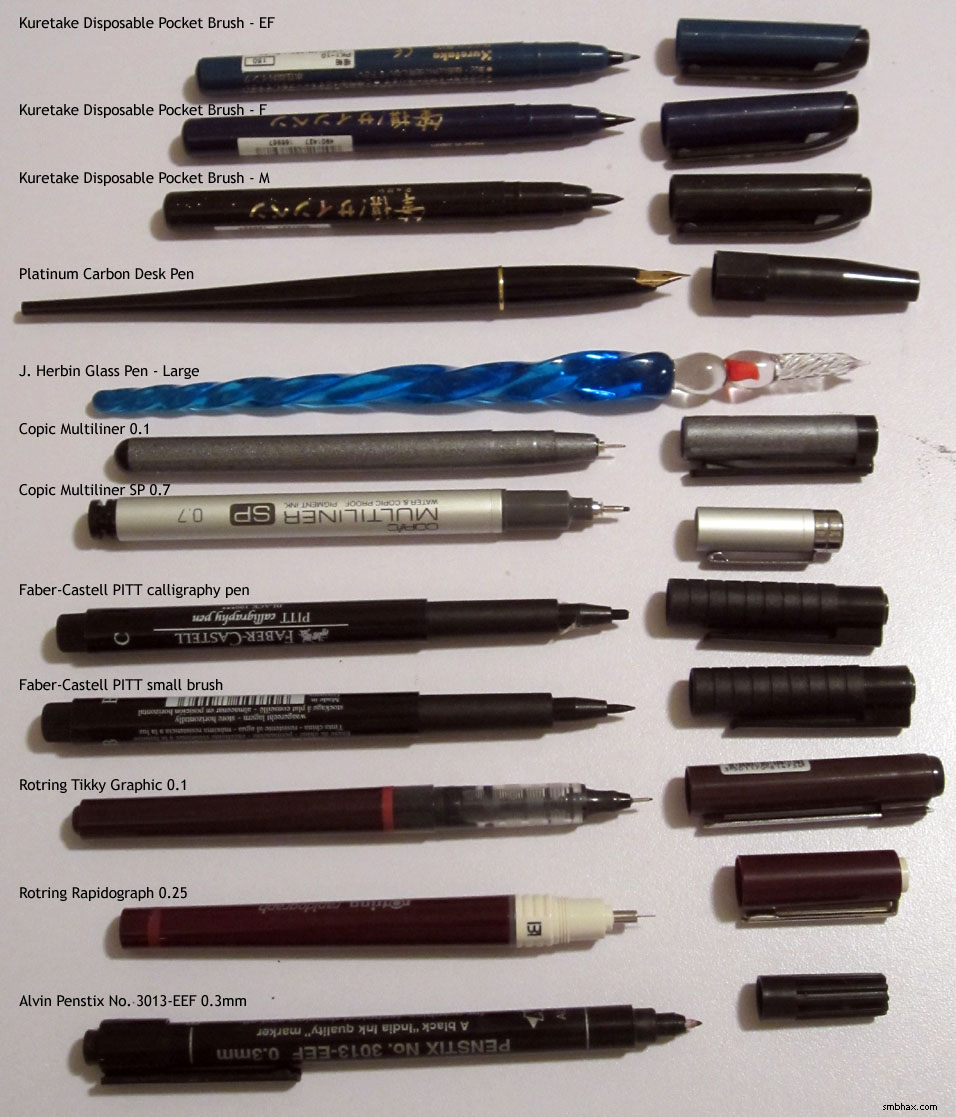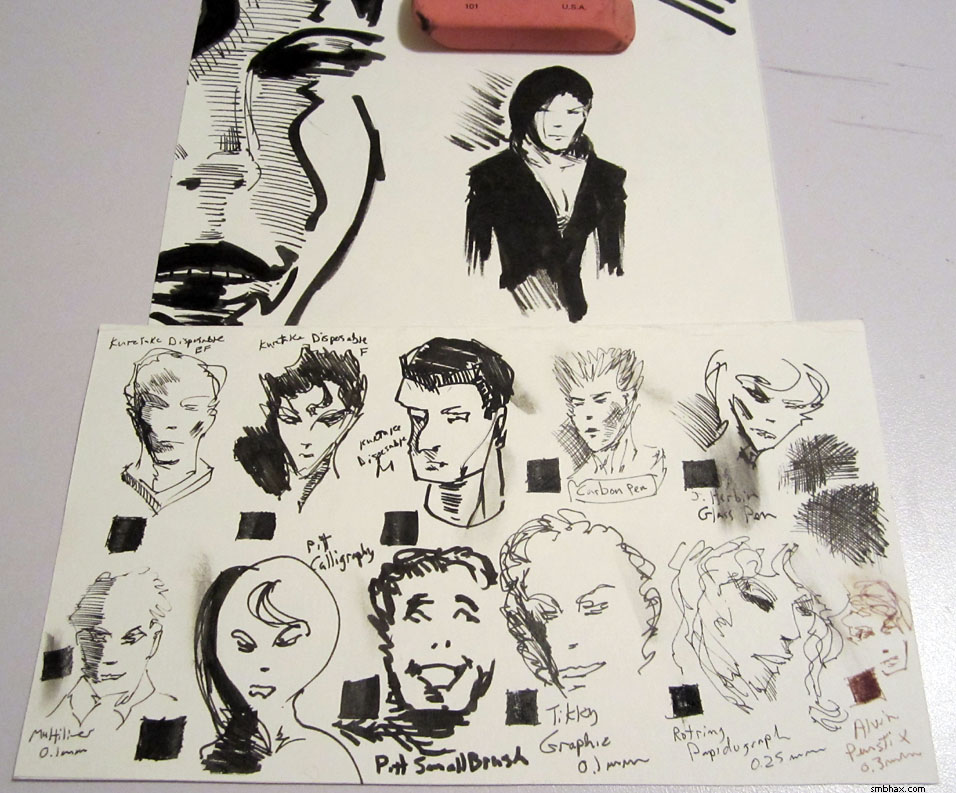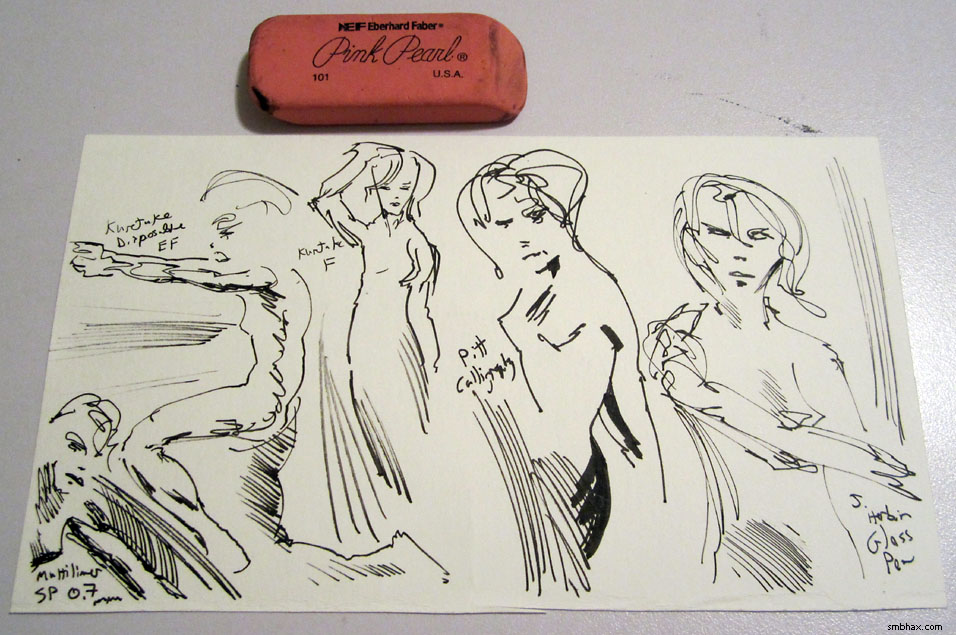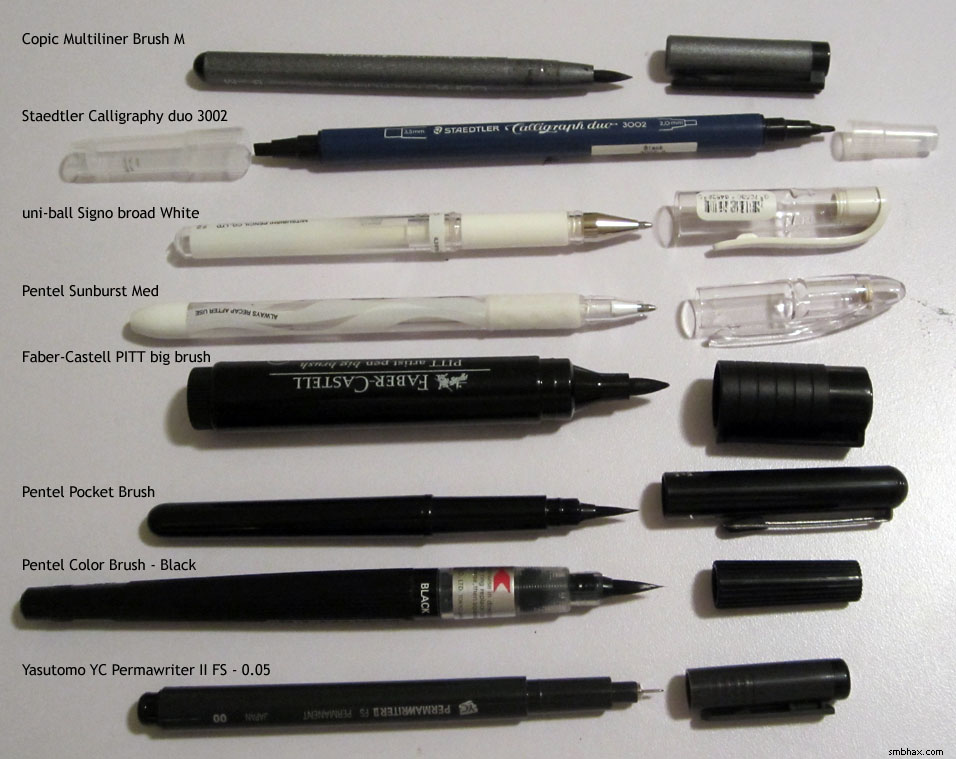Added 1 new A* page:~~~~~~~~
Are you ready for a Supermassive Black Pen Round-up? Well tough luck, because you've just landed on one! Starting at the end of the last episode and running a good way through this one, I was a bit obsessed with finding pens I could use to do the art for A*, either in tandem with a brush, or on their own. I'm pretty much back to all brush now, but I've got all these pens laying around, and some test sketches I did with some of them, so I might as well say a word or two about them. For the most part, the exotic ones can be found at Jetpens, and the rest at Dick Blick. Also for the most part, their ink isn't as black as say the inks I covered in my recent Supermassive Black Ink Round-up; all of them (unless noted otherwise) are quite adequately waterproof.
Here was the assortment I was thinking I might use for A* at one point (except the last one :p) (these photos are angled away a bit, so the upper pens appear slightly smaller by comparison to the lower ones than they actually are):

And here are the test sketches (on Canson Illustration paper, with finger smudge to test their waterproofness):

Kuretake Disposable Pocket Brush
I found out about these fancy-looking yet disposable Japanese markers by asking comic book artist Mike Mayhew what he had used to draw this nifty sketch of Aquaman--he'd used these! Most disposable Japanese art markers, and especially brush markers, are not waterproof, but these are, and they're quite reasonably priced as well. The EF and F sizes have hard little conical tips that lay down very fine, even lines. High quality stuff, no doubt, and their solid plastic construction with gold embossed calligraphic lettering and gold sparkles only adds to that impression--the caps click on and off with a very satisfying firmness. There's a bit more resistance when moving the tip over paper than I would like--almost a rubbery stickiness, but not quite--but that's the only nit I can pick with these, although it is rather equivalent to a nails-on-chalkboard sensation for me compared with, say, a brush. Hm, I suppose you could say that they run a little dry, but I would find later that that's necessary for doing non-damaging work on paper. The tip of the larger M size is different--much bigger, and softer--and I found it much less pleasant to work with than the two smaller sizes; it's just an awkward balance between hard and soft, big and small--if I were gonna use these I'd use the two smaller sizes, and probably a Copic Multiliner M brush instead of the Kuretake one.
Platinum Carbon Desk Pen
This is a pretty neat pen. It's actually a fountain pen! Rated EF (extra-fine), but apparently Japanese fountain pens are pretty much a size smaller than their Western equivalents, so it's more like a "super-fine" nib; normally, I hear, a nib this fine would feel pretty scratchy, but this pen is actually pretty smooth, and quite pleasant to write with. If I wanted to feel fancy while writing something, I would use this. Even so it isn't very expensive at all; in fact, the reason I got it was really just to try Platinum's "Carbon" ink that it comes with in a couple disposable refill cartridges, because this pen was cheaper than a small bottle of the ink alone. And it does lay down a very fine, smooth line, but I couldn't use it for A* because, like dip pen nibs, it tends to chew up the surface of the paper, especially if you're going over ink wash or something. The "Carbon" ink, which is apparently a super-fine India ink (even so, this pen supposedly needs its special wide feed to avoid being clogged by it), is quite waterproof, but not really very black. Being a "desk" pen, it's meant to sit holstered in a swivel cap attached to a fancy base sitting on your fancy desk, so it has a long, tapered body (with a hole at the end, it should be mentioned, so it can't be converted to an "eyedropper" pen by filling the body with ink) that doesn't allow "posting" of the cap. It's pretty light and comfortable to hold, though.
J. Herbin Glass Pen - Large
I didn't even know these existed until I saw and heard (they make this great glass fluting sound as their tip moves across paper) them in this video; glass pens like this, apparently, are used for testing inks, since you get a good view of the ink as it sits and flows in the twisting channels on the large glass tip--so it works like a dip pen, ie you dip the tip into your jar of ink (I was using Yasutomo Waterproof Black Sumi), and then write with it until all the ink has been sucked off the fluted tip and onto the paper. Pretty neat! This French glass pen didn't seem to hold as much ink in its flutes as a standard dip pen nib does in its reservoir, and like a dip pen nib it did tend to scratch up the paper's surface. I tried rounding the tip--which came with a definite point--using some fine sandpaper, as suggested on the box, but didn't really manage to tone down the paper damage much. Unlike a dip pen, the glass tip isn't flexible at all, so you get no line width variation whatsoever; this does make them handy if what you really want is an even line, though. And they just look (and sound) darn cool.
Copic Multiliner 0.1
Multiliners come in a variety of somewhat odd, small sizes (like 0.03, 0.05, 0.1, 0.3, 0.5, 0.8, 1.0 mm), but of the various types of similar technical or whatever you call 'em markers that I tried (the others were Sakura Pigma Microns, Staedtler whatevers, and Faber-Castells PITTs), the Multiliners had the finest size (the others were 0.05 mm at the smallest), and possibly fractionally the darkest ink and most even lines. I used Multiliners on a good number of the pages earlier in this chapter. You don't really get width variation out of their hard conical tips, but they're actually pretty good at feathering, if you flick them just right. They may feel a little dry if you're used to regular markers, but--as I found with wetter technical markers (see the Tikky Graphic, below)--they're pretty much as wet as you can get without risking real damage to the paper surface due to saturation weakening the fibers of the paper, which would then yield too easily to the hard marker tip. I like the narrow, round bodies of these markers, and their dark gray, silvery sparkled surface, but it's a light plastic that feels a bit cheap, particularly with the cap, which just sort of snugs on and off rather than clicking, and which posts very fudgily on the end; I had a few dry out on me between uses, and I think that might have been because the cap wasn't really on as tightly as it needed to be. I also had a few just die on me rather quickly; these have no cartridge or visible reservoir, so you don't have any warning as to when one might expire. I also killed a bunch of them by getting the tips clogged with white ink, it must be said--even though no white ink might be visible on the tip, the marker would just never regain its full ink flow. A few of the mystery dead ones did manage to revive, however, after I left them standing upside-down for a day or two. When they work, they work well, but they aren't the most reliable pens around, and you can't do *really* fast lines with them without skipping, due to the carefully measured ink flow.
Copic Multiliner SP 0.7
These are the refillable, metal-bodied versions of the Multiliner, and are in theory the more economical (and ecological?) option in the long run since you can replace the tips and ink cartridges. I don't really like the metallic chill you feel when first picking one up that you haven't handled in a while, but they warm to the touch pretty quickly, and unlike the disposables, their small caps click into place with satisfying security--although they don't post as securely as one might like. Rather confusingly, the sizes they come in are slightly different than the disposables, in some cases.
Faber-Castell PITT calligraphy pen
For a while I thought this was THE pen I was going to use--you can get a lot of line variation by using different edges or corners of the 2 mm, fairly hard sloped chisel tip, and it puts out a satisfying amount of ink--or more than the Multiliners, anyway. Very fun to play with a fresh one of these. But! I found that the tips are rather unreliable, and can lose their ink flow without warning; the one in the photo actually has a bit of masking tape around the far side, just below the tip, to remind me that that corner is pretty dead. Frustrating! They also sometimes shed a fiber or two--you have to go and pluck it off with tweezers or something--at the beginning. These may be even less reliable than the disposable Multiliners. Also, even the caps can be a bit flakey; the button at the end is a separate piece, for some reason, and it sometimes gets a bit loose, which somehow makes it so that the cap, which usually clicks firmly into place, doesn't click closed anymore unless you press the end of the cap down as you slide the cap into place; very surprising given how solid the rest of the body feels.
Faber-Castell PITT small brush
Has a harder tip than Japanese "brush" markers, but it's so narrow that it tends to feel a bit woggley, whatever that means. Just didn't like the feel or the sort of intermediate size. Has the same flukey button cap as the PITT calligraphy pens.
Rotring Tikky Graphic 0.1
Another line of technical markers like the Multiliners, etc. I like that these come in regular, tenth-of-a-mm sizes, though. Though disposable, they feel extremely solid, and the large caps even have metal clips. They also have an ink reservoir view window so you can tell when you're running low; Rotring's marketing claims that the reservoir and feed design ensures they use every last drop of their pretty generous ink supply, but I haven't used enough to verify that. They also give out by far the most ink of any of the technical marker lines I tried; this is great if you're just doodlin', as you get nice even, wet lines even when moving quickly, but if you're really trying to go into some detail, or if you're going over paper that's been wet previously by a wash or something, the paper surface will tend to get oversaturated and then get chewed up by the marker's hard conical tip pretty easily. Also, they cannot do feathering at all; as soon as you touch the tip to paper to any degree, you get the full ink flow.
Rotring Rapidograph 0.25
I included this since I had it laying around, although I knew from when I covered it previously that its hard metal tube tip can't draw lines very quickly without skipping, and chews up the paper like nobody's business. It can't really be beat for fine, even lines, though. I don't think I'll ever get used to the screw-off cap on this thing--I keep trying to yank it off. :P
Alvin Penstix No. 3013-EEF 0.3mm
Saw this in a local art store; it is shockingly awful. The ink is brown! I had to double-check that the pen body said "black"; it does (although I notice now that the "India ink quality" after that is in quotes ;P), but man that ain't no black. The small cap with sharp fluting doesn't snap into place, and the narrow body with fixed plastic clip at the end and 90-degree edges toward the tip doesn't feel engineered for any kind of pleasant user experience. The tip is of the small, hard, conical (and spongey) variety. Do not get this unless you really need a brown, uncomfortable small marker.
~~~~
So of those I felt the Kuretake EF and F, Pitt calligraphy pen, Multiliners, and J. Herbin glass pen were the best with an eye toward A* work, so I did another, slightly larger set of sketches with those finalists:

The PITT calligraphy pen was by far the most fun to use, and you can see there that I was getting the most solid lines out of it.
~~~~
Here's another crop of pens I have laying around from my pen-speriments:

Copic Multiliner Brush M
I felt this was worth mentioning on its own, because the large, somewhat soft "brush" (it isn't really like a brush at all, mind you) felt or whatever tip has a kind of pleasing squishiness and wetness to it. I don't really like it for doing big line work, because it doesn't feel firm enough to me for a really reliable line, but it's very good at filling in large areas. These only come in the disposables--the metal "SP" line just has the small brush, which isn't nearly as satisfying. The soft tip *does* tend to fluff out and lose its shape fairly quickly--well before it ran out of ink, for me--which is a shame, but I haven't found a soft marker tip that has found a way to avoid that problem.
Staedtler Calligraphy duo 3002
There aren't really many waterproof black pigment ink chisel tip markers out there, so when I saw this I figured it was worth a shot even though dual-tip pens drive me buggy for some reason. The clear plastic caps can post to each other, so *that* isn't a problem, at least. The 3.5 mm and 2.0 mm chisel tips are harder than the tip of the PITT calligraphy pen; I'm not sure if that means that they're more reliable, but they *are* more prone to chewing up the surface of the paper. Other than that it seems like a very solid pen.
uni-ball Signo broad White
I was turned onto this white gel pen--which I thought might be useful for touch-ups--by a couple white pen reviews I found after I got the Sunburst (see below) and wanted to see how it stacked up. The Signo seems to be the most highly recommended white gel option, and it is indeed much more generous and opaque than the Sunburst. It is not (and doesn't claim to be) waterproof at all and, being a ball point, runs into the problem where the generous line of somewhat thick ink is divided by the metal tip laying it down, so you get a kind of two-line effect, which probably isn't desired in most cases.
Pentel Sunburst Med
Picked this up on a whim at a supply store; does offer some non-waterproof white gel ink coverage, but the ink isn't quite as thick or as opaque as could be; also seems to dry up slightly more easily than the Signo, and shares the two-line problem with the ball point tip.
Faber-Castell PITT big brush
Of all the pens here, this is the sole one that I'm really still using, if just for sketching (I did do a page or two of this episode with it almost exclusively, though). The large brush tip is quite firm, which doesn't seem nice at first if you're used to softer Japanese large "brush" pens, but it holds up very well with use, taking much longer to lose its shape. Faber-Castell claims these carry something like four times the ink of their regular-sized PITT markers; I'm not sure about that, but I can say I haven't "hit bottom" on one yet--they seem to run into a diminished ink flow some time before that, at which point I don't like them anymore and have to go get a new one. Until that point, though, they put out a very nice, even wet line. The ink is not of course quite as dark as brush inks, but if you layer it up--which is easy to do thanks to the large tip and generous ink flow--it can achieve this kind of nifty, velvety black gloss, which is nice to look at even if it doesn't scan well due to being somewhat reflective. I was a bit wary at first of the large, firm tip, fearing it would be clumsy, but while it can't make a *very* thin line, you can get a reasonable amount of width variation by holding it at different angles, and it is by far the best of any of the markers I tried at laying down big, fast, long, solid lines, and it is of course great at filling in large areas--this is really the only marker I've found that can keep up with my frenetic, heavy sketching. The hard plastic body feels very solid, the thick cap clicks into place definitively, and I haven't had one have the loose-button-cap problem the smaller PITTs sometimes have. Very reliable and quite affordable for how much pen you get.
Pentel Pocket Brush
This brush pen actually has individual brush hairs at its tip like a real brush, although they're nylon or something, and actually cut and angled inward to form a sharply tapered point; this seems to mean they always keep a very sharp tip, but at the cost of overall brush strength: there's no real snap or flex here--they're either dragging a loose line, or squooshing into the paper. They're very popular for their portability, though--no having to carry ink and rinse jars around with you--and some webcomics get good results with them. Their ink is waterproof and surprisingly dark--I wish Pentel sold the stuff in bottles! Alas, it only comes in small disposable cartridge refills. The pen body, though plastic, feels very solid indeed, but with a graceful, rounded, stylish exterior--top marks there. In theory these could be converted into eyedropper pens, I think, and I *have* read of some people using Platinum Carbon ink with them, although in theory that risks clogging issues. The small, black Selenis sketch above the other pen test sketches earlier in this post was done with this pen; as you can see, it is pretty handy at big black fill, and feathering, but I at least am pretty much unable to get hard, even lines out of the weak tip. (The big face next to that sketch was done with PITT big brush and calligraphy pens; it was an early attempt at I think page 26.)
Update 5/29: Since I've mostly moved away from regular pens now, I've found myself going to the Pocket Brush lately when I want to do a quick sketch, or even just for when I need something brushy and fast, like for signing paintings. It is quite a handy thing! I should note that although the ink is darker than most of the marker-type pens, it isn't nearly as dark as a good stand-alone ink such as you would use with a regular brush.
Pentel Color Brush - Black
Larger, uglier cousin of the Pocket Brush. The Color Brushes are not waterproof, but come in a variety of colors, and I guess they're meant to be used as portable watercolors, sort of. Should be able to hold much more ink, too, because the large, squeezable body is a single large refill cartridge. You're suppose to squeeze it to get ink to flow--unlike the Pocket Brush, which just flows at a set rate automatically--and in theory this offers much more control and variety, as you could use it for dry brush, spatter, and so forth; when I tried it, though, instead of saturating the tapered nylon bristles all the way to their tips, the ink just gushed out the sides and dripped in a big slash right onto the page below. :o And again, the weak tip isn't my thing, but some people get pretty darn fine black and white sketches out of them.
Yasutomo YC Permawriter II FS - 0.05
Saw this at some local store and figured it was with a shot since I was using Yasutomo's sumi ink anyway. The design of the pen body is uncomfortably severe, and the line its fine conical tip puts out is a bit squishy, and not up to par with other technical marker lines in that respect. It was, however, the most waterproof of any of the pens I tried--supposedly they're even permanent on CDs and so forth.
~~~~~~
That ends the Supermassive Black Pen Round-up! I will probably not bother you with pen talk for a while as I'm back pretty happily with the brush these days, but I suppose you never know what the future holds!
|
